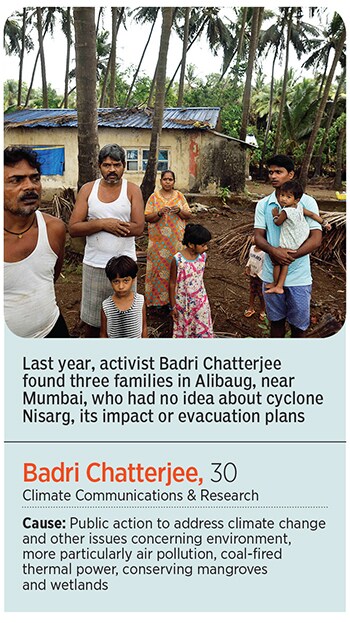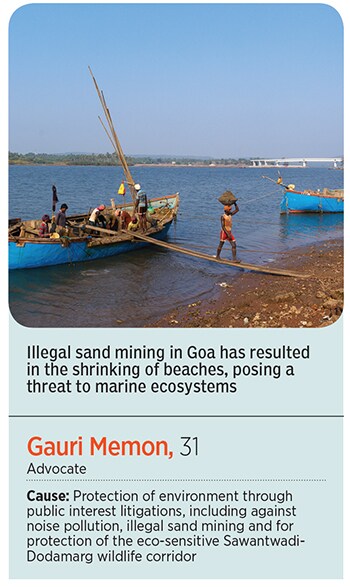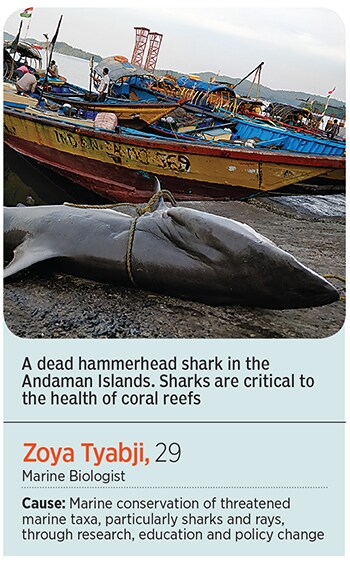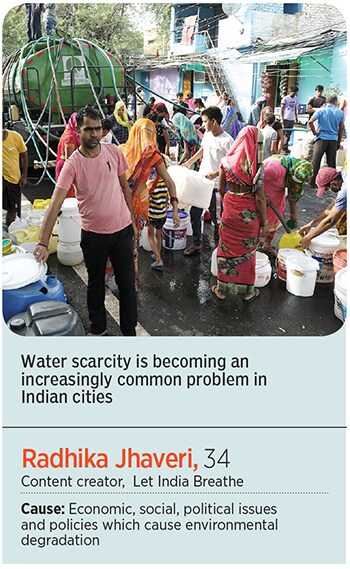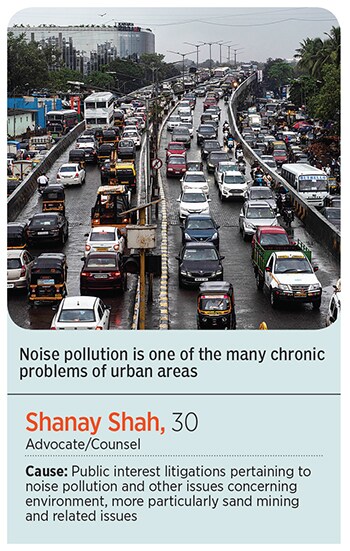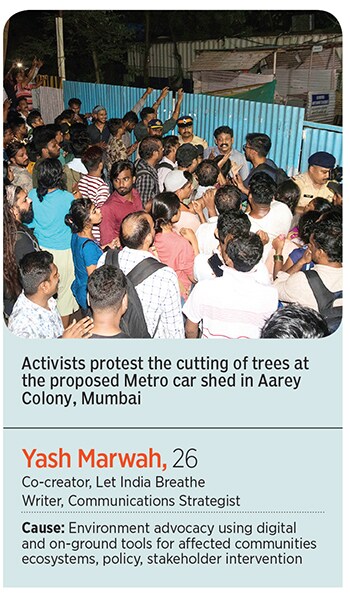“To me, there is no comparison between the value of a forest and the perceived value of diamond jewellery," says youth leader Radhika Jhaveri poignantly. She grew up in a society where diamonds symbolised wealth, status and success. However, in her early 20s, she learnt that humans die and the environment suffers for diamond mining. Radhika decided then that she would not buy or wear any jewellery at all. “One [the environment] sustains life and the other [diamonds] brings about nothing but destruction. It’s a cost I am not willing to pay," she says.
Diamonds are not the only reason for destroying biodiverse forests.
Our irreplaceable forests are destroyed daily for development projects like roads and infrastructure building, coal and mineral mining. Sand mining ravages rivers and coasts across India. Even our seas are polluted and over-fished. What we call ‘development’ has caused historically unprecedented climate change. This explosion in man-made infrastructure and waste, without environmental precaution, is making our world unliveable for our descendants.
A draft 4,000-page United Nations (UN) Report leaked in June 2021 warns: “The worst is yet to come, affecting our children’s and grandchildren’s lives much more than our own." It adds: “Species extinction, more widespread disease, unliveable heat, ecosystem collapse, cities menaced by rising seas—these and other devastating climate effects are accelerating and are bound to become painfully obvious before a child born today turns 30."
Young people have known this before the UN articulated it. Their leadership—individually and collectively—has forced the establishment to change and the UN to acknowledge looming climate change. Other than activism, young people have spearheaded legal battles, awareness campaigns, news reports and scientific research. Each person contributes differently and use different language—of the lawyer, journalist, researcher, activist—but their message is universal. They are urgently and passionately dedicated to opposing accelerating climate change. Their varied skills and methods have created a powerful presence, and their combined voices resonate demanding change at every level of governance and on the ground.
![]()
Badri Chatterjee is one young climate communicator and former journalist. He speaks vividly of his experiences reporting on the ground, and highlights the personal insights gained from covering the Nisarga cyclone in 2020. At Alibaug, near Mumbai, he met three families who were in grave danger hours before the cyclone’s landfall. Then, he understood the logistical difficulty of aiding climate-affected people, as they had not vacated their homes despite being less than 2 km from the Alibaug district administration office. They had been preoccupied with the Covid-19 crisis and did not even know that the cyclone was approaching.
Once the local administration was made aware, the families were crammed inside a make-shift shelter in a local school despite Covid.
“I experienced first-hand the sheer magnitude and force of nature when winds at 125 kmph destroyed anything and everything in their path it made me realise the insignificance of humanity on the speck of this earth and within nature, and what we must do to save ourselves from this climate crisis. The Earth will survive as it always has… it is us who will suffer the worst effects of this crisis. We are responsible for answering our future generations," says Chatterjee.
Beach sand-mining affects both land and sea, as sand forms the intertidal zone where mangroves, fish and migratory birds thrive. Sand also offers protection to the land and to water tables, especially as sea levels rise. Gauri Memon is a young lawyer who realised the importance of sand in her early 20s. She had a life-changing opportunity to work on a public interest litigation (PIL) against illegal sand mining which resulted in policy change. She remembers how, while growing up, she visited her ancestral home in Goa during most summers. The beaches now have drastically changed. “I have seen how the sand on these beaches has drastically reduced and the shoreline has receded. Sand mining is a glaring environmental hazard that needs immediate attention. It’s a long and sometimes thankless journey, but I intend to do my bit and never give up," she says.
![]()
Earth’s first mammals came out of the sea onto land, and yet we do not even know the full extent of what precious biodiverse life we will lose in neglecting the effects of climate change on the sea. Warming seas severely impact climate, give rise to more serious climate events and affect the entire marine and terrestrial ecosystems.
Marine biologist Zoya Tyabji is an expert on sharks, an apex predator of the sea and one of the oldest life forms on Earth which evolved more than 400 million years ago or 200 million years before dinosaurs. She spent her summers growing up at the beach in Kihim, Alibaug. “I realised that the ocean is my therapy—it inspires and relaxes me. Over the years, I also saw it erode through tourism and industrialisation. This brought out an emotional commitment to dedicate my life through education and deep research to defending it," she says. At 25, Tyabji became fascinated with sharks while working on coral reef resilience in the Andaman Islands. She often heard that sharks play an important role in the health of reefs, and so she was surprised when she did not see any. And yet several reefs were called ‘healthy’. The local communities informed her of steep declines in sharks due to overfishing. “I wrote a grant for funding and led a study on sharks by visiting fish landing sites, aided by my team member and with my supervisors mentoring me. My experiences motivated me to pursue a PhD to build more information and awareness about sharks," she says.
![]()
Developmental measures of success, like GDP growth through expansion of urban spaces and infrastructure, encourage our leaders to prioritise industrialising our world at the cost of nature. Afraid of the consequences of irreversible climate change in the world they must live in after we are gone, young people have taken on the difficult burden of integrating new, sustainable habits into their own daily lives.
Radhika Jhaveri is terrified of life in a world where water scarcity becomes the norm, and sees the real possibility of water becoming severely scarce in the near future. Major cities in India are already struggling with water scarcity. The immense scale of climate changes causes her eco-anxiety, depression and pessimism with regard to the future. It affects
her core decision-making, especially on whether to have children. “It is very much a personal battle for a number of reasons. I do not want to live in a world where people have to fight for access to clean, drinking water. Where the air we breathe is toxic. And I certainly do not want to bring children into this world," she says.
![]()
A mother and a lawyer, Gauri Memon echoes this concern for future generations. She highlights that with her two-and-a-half-year-old son, it is a primary goal for her to create environmental awareness in him, to raise him to always value environmental protection.
A PIL allows any ordinary person to take up issues of public importance and impact policy and its implementation. Another young lawyer, Shanay Shah , says every budding lawyer is told that one should not associate themselves with their clients or their matters. But for him, the PIL against noise pollution, his first environmental litigation, did become personal as it was for an important public cause. It is rewarding in many ways and helps understand public governance and the administrative shortcomings in the implementation of rules and the applicable law. “Having appeared in the PIL for implementation of noise pollution rules, the reward for me was to see how the guidelines/directions issued by the Bombay High Court were implemented and to see the increase in awareness among the public at large. Simply put, one hardly needs motivation to espouse a genuine public cause," he says.
![]()
Deep-sea diving, forest bathing and hikes in wild areas along with exposure to cyclones and experience with legal interventions have motivated young people towards action. “Societal movements, for example youth groups, had mainstreamed climate- and environment-related issues on the agenda of decision-makers across all levels of governance and partially the private sector," said the Global Youth for Environment of the UNEP while announcing its Earth Day 2021 event in April.
Online activism is sometimes referred to dismissively as ‘clicktivism’. However, it became mainstream, proved its efficacy and really came into its own during the Covid-19 lockdown. While on-ground protests became impossible during the lockdown, a draft Environment Impact Assessment Notification 2020, (EIA is a tried-and-true method to determine impact on the environment prior to project approval in sensitive areas) was circulated and youth-led opposition to some clauses found its medium on social media.
“Thousands of people have responded and I welcome their comments and suggestions. Some people are so excited that they have started campaigning now," said then Union Minister of Environment, Forests and Climate Change, Prakash Javadekar.
![]()
“The #WithdrawEIA2020 campaign gained momentum through online activism by almost 40 youth groups, including Let India Breathe, Fridays For Future and There is no Earth B, when more than 20 lakh objections were mailed to the environment ministry. Online activism is a fantastic and very powerful tool. While citizens can organise and communicate with their governments, if used correctly, it is a great mode of direct communication," explains Yash Marwah of Let India Breathe. As a result of young people’s intervention, the draft EIA was placed on hold and sent back to be reworked.
It’s been decades since I have seen a mink coat on the red carpet, though diamonds remain ubiquitous. “In the face of climate change and glacier bursts, we don’t want diamonds," read another youth-group Instagram post.
Apart from giving impetus to online activism, the Covid-19 lockdown unmistakably demonstrated the importance of controlling climate and environment to avoid future disasters even worse than this pandemic. At least the sixth global health pandemic since the Great Influenza Pandemic of 1918, the UN estimates that another 1.7 million currently ‘undiscovered’ viruses exist in mammals and birds of which up to 827,000 potentially have the ability to infect people. It has drawn links between environmental degradation, climate change and pandemics, and stressed that like all pandemics, its emergence has been entirely driven by human activities.
The squeak of a bird startles in the sudden quiet before the storm. Darkness descends rapidly and I hear a leaf fall, rustling on the dry ground. The first raindrop is loud on the roof above my head. The first of the devastating rainfall creating landslides, floods and loss of life in Maharashtra in July.
“Life on Earth can recover from a drastic climate shift by evolving into new species and creating new ecosystems… humans cannot," says the leaked UN report.
Our youth will be most impacted by climate change. Their passionate voices have supported and encouraged each other, resisted climate change in fresh ways and forced us to listen. They carry our hopes and dreams forward into the future. They need forests, not diamonds.
(Sumaira Abdulali is convenor of Awaaz Foundation)
•With additional inputs from Laika Abdulali, JD Yale Law School & PhD candidate, University of California at Berkeley

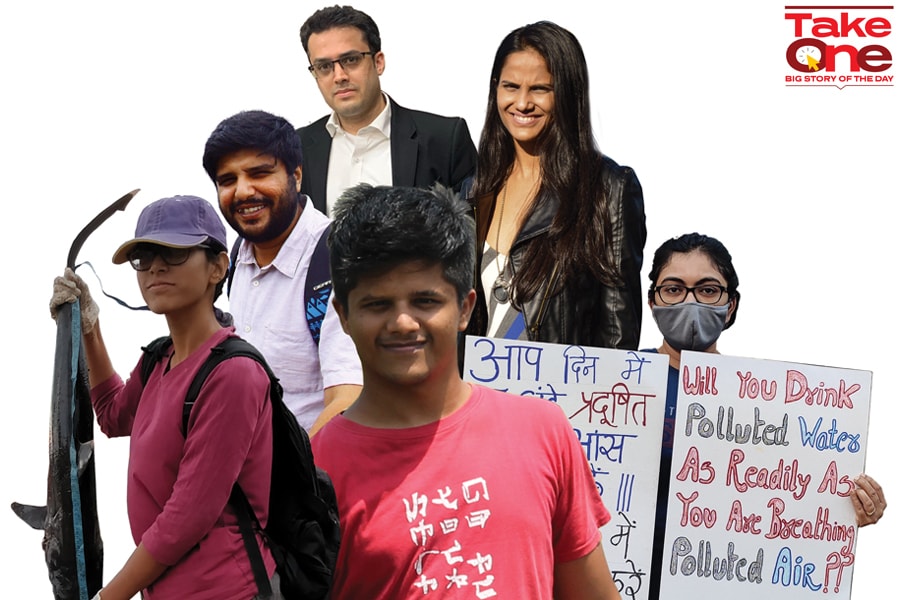 (Clockwise from right) Shanay Shah, Gauri Memon, Radhika Jhaveri, Yash Marwah, Zoya Tyabji, Badri Chatterjee[br]
(Clockwise from right) Shanay Shah, Gauri Memon, Radhika Jhaveri, Yash Marwah, Zoya Tyabji, Badri Chatterjee[br]